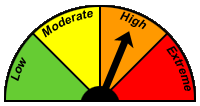The Ontario Fire Season runs April 1st to October 31st each year. The rating is verified daily and updated whenever the rating changes.
A Low Danger Rating means fires may start easily and spread quickly but there will be minimal involvement of deeper fuel layers or larger fuels.
A Moderate Danger Rating means forest fuels are drying and there is an increased risk of surface fires starting. Carry out any forest activities with caution.
A High Danger Rating means forest fuels are very dry and the fire risk is serious. New fires may start easily, burn vigorously, and challenge fire suppression efforts. Extreme caution must be used in any forest activities. Open burning and industrial activities may be restricted.
An Extreme Danger Rating means extremely dry forest fuels and the fire risk is very serious. New fires will start easily, spread rapidly, and challenge fire suppression efforts. General forest activities may be restricted, including open burning, industrial activities and campfires.
A “Restricted Fire Zone” (RFZ) is an Order made by the Minister of Natural Resources, under the Forest Fires Prevention Act, that restricts the use of open fires in a specific area of the province. It is used when the fire hazard is extreme and/or when fire fighting resources are stretched to capacity. RFZ Orders are strictly enforced.
A No Data Available rating will show in place of the rating when there is no information available from the MNR. This usually occurs outside of the normal forest fire season.
The Fire Danger Rating is determined using the Fire Weather Index (FWI), an internationally used method for determining the risk of fires in open air. It uses factors such as the relative humidity, temperature, previous 24-hour rain amount, wind directions and wind speed in combination with the forest fuel type and loads to determine the risk of the forest to certain fire types. From this calculation the Forest Fire Danger Rating is made available by the Ministry of Natural Resources, Aviation, Forest Fire and Emergency Services (AFFES).
Open Air Burning in Shuniah requires a Permit. Residents are reminded to be careful with your outdoor burning; keep fires under control and do not burn when it is windy.
If you light a fire, you are responsible for it. This means if you light a fire and that fire turns into a wildfire you can be held responsible for the associated costs of putting that fire out. This can range in to the thousands of dollars.
More information about wildfires and the current fire situation can be found on the MNR Fire Situation Page.






